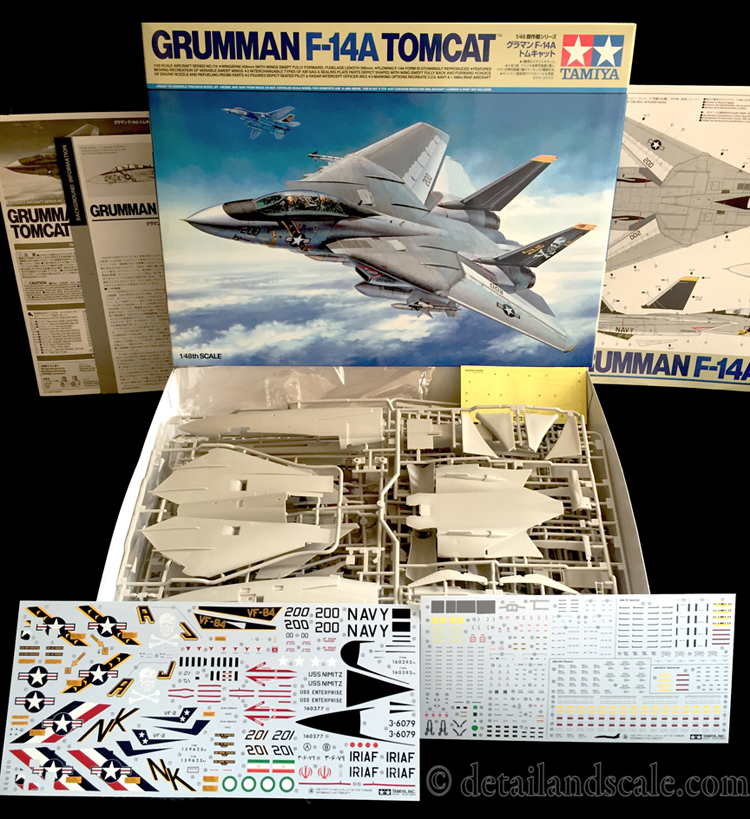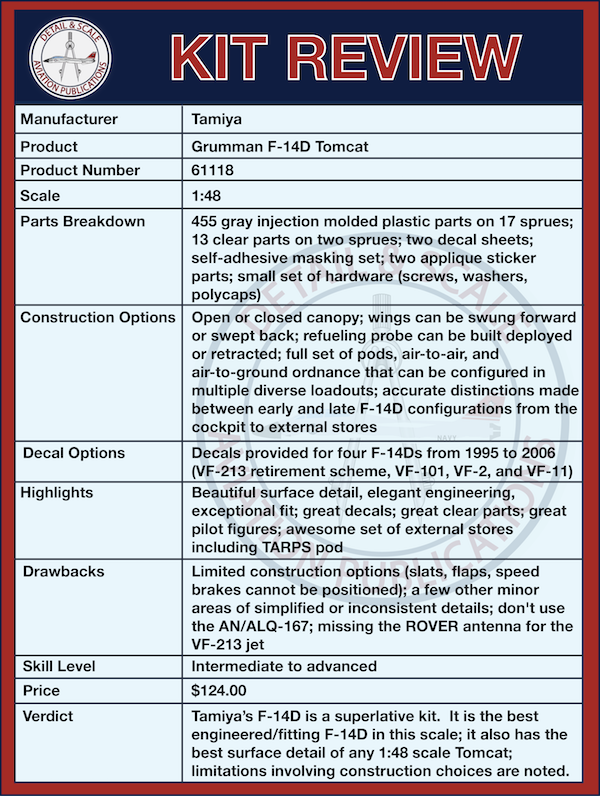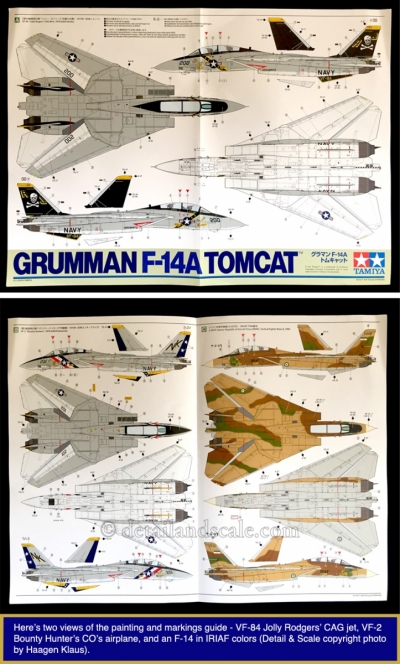Tamiya Grumman F-14A Tomcat — 1:48 Scale


For decades, the Grumman F-14 Tomcat has been a favorite among scale modelers, aviation enthusiasts, and aviators. Over the years, there have been – by my count – no less than 385 different issues of F-14 kits from 1:144 to 1:32 scale. The quality and accuracy of these kits varied, from early Airfix and Matchbox products to classic kits by Testors, Monogram, and Revell. Generally, the best F-14 in 1:48 scale is often thought to be the Hasegawa family of Tomcats that first hit the market in 1988. While they’re very good, the Hasegawa F-14s are also infamous for various construction glitches and areas involving ill-fitting parts. Hobby Boss launched a more modern tooled and designed F-14 family in 2010. Despite their promise, Hobby Boss Tomcats were plagued by rather misshapen intakes and notably inaccurate surface details. In 2016, Tamiya finally stepped into the ring with a new-tool F-14 in 1:48 scale, looking to be a contender for the title of “Best 1:48 scale Tomcat.” In this review, we’ll take a very careful look at this hotly anticipated kit.

The F-14 Tomcat hardly needs an introduction, famous through its 32 years of active duty. Tomcats played central roles in both relatively limited actions from the Gulf of Sidra to Grenada, the Persian Gulf, and Lebanon to more historic events beginning with the evacuation of Saigon to Operations DESERT SHIELD/STORM, ALLIED FORCE, NOBLE EAGLE, ENDURING FREEDOM, and IRAQI FREEDOM.
Born from the ashes of the F-111B program of the late 1960s, the F-14 was originally conceived as a long-range interceptor fielding the AWG-9 radar/Phoenix missile combination, protecting U.S. Navy battle groups from long range Soviet bomber and cruise missile attacks. The F-14 was also the first American aircraft to apply the hard lessons being learned in the Vietnam war, such the need for an internal cannon, 360 degrees of visibility, and excellent maneuverability. It had a unique airframe, in part owing to its variable geometry (or swing) wings that quite literally changed the airplane’s shape in the air to optimize for either high- or low-speed flight. Particularly with its wings full forward, the F-14 was a potent dogfighter, famously capable of ‘bat turns’ that could allow the large interceptor to keep up with and gain the advantage over the most nimble of opponents. With the development of the TARPS pod system, the Tomcat added aerial reconnaissance to its bag of tricks, and by the mid 1990s, it also evolved into outstanding strike fighter and forward air controller (informally nicknamed the “Bombcat”) with the addition of a LANTIRN targeting pod and precision laser- and GPS-guided munitions.
Grumman manufactured some 712 Tomcats between 1970 and 1992 across three major variants. Most, of course, were F-14As fitted with the often-troubled and underpowered TF-30 engines. The last U.S. Navy Tomcat was retired in September 2006 capping a celebrated 32 years of service which included five air-to-air victories and many thousands of tons of ordinance dropped and thousands of targets destroyed. The Iranian Air Force still operates F-14As that were exported before the fall of the Shah in 1979. During the Iran-Iraq war, Iranian F-14s reportedly shot down at least 160 Iraqi aircraft, though this figure has proven difficult to verify. Iran’s remaining Tomcats (probably around 30 of the original 79 jets) have today been significantly overhauled and upgraded to probably fly on for another 10 years before they, too, are retired.

Tamiya’s new tool F-14A represents an early production block Tomcat. It comes in a sturdy box with just enough room for all the parts. Eleven gray injection-molded sprues hold 373 plastic parts. These include a full set of four Phoenix, four Sparrow, and two Sidewinder missiles along with a pair of drop tanks. Six clear parts come on one clear sprue. Pre-cut painting masks for the windscreen and canopy are also included (thanks, Tamiya!). Two decal sheets cover the markings for three F-14As and airframe and missile stencils (including landing gear data placards). The instruction booklet is accompanied by a fold-out booklet summarizing the Tomcat’s history and loadout configurations in Japanese, English, German, and French. A double-sided full-color painting and decal placement guide is also included for the following jets represented on the decal sheet:
- F-14A BuNo 160393, VF-84 Jolly Rodgers CAG bird, USS NIMITZ, 1979
- F-14A BuNo 159625, VF-2 Bounty Hunters CO’s jet, USS ENTERPRISE, 1976
- F-14A BuNo 160377, Islamic Republic of Iran Air Force, Tactical Fighter Base 8, 1980
Strengths: In addressing the strengths and weaknesses of this kit, I am looking at through several different lenses – from that of a plastic model kit to be judged on its own merits to how it compares with other 1:48 scale F-14s and my own detailed knowledge of the Tomcat.
Just on its own merits, the Tamiya F-14A is a beautiful and exemplary kit – it’s truly a scale modeler’s kit. It features excellent molding, elegant recessed panel line and fastener/rivet detail, and a high fidelity of accurate detail on parts such as the cockpit, ejection seats, intake ramps engine exhaust nozzles, and missiles. Comparing these with my various sets of F-14 line drawings, this new Tamiya kit appears to be very size and shape accurate. Also, the jets represented on the decal sheet are early Block 74, 75, and 76 F-14As. Tamiya accurately represents the configuration of these Tomcats, from the configuration of the gun gas purge vents on the port side of the nose, to the sole AN/ALQ-100 chin pod, early-style wheel hubs, and the vertical stabilizer fin cap stiffeners are correct for Block 74-76 F-14As. Tamiya nailed it. The attendant depth of research that Tamiya’s designed devoted to this kit is very clear.
I’m also quite happy to say that the various shortcomings of both the venerable Hasegawa kit and more recent Hobby Boss kit have not been repeated in the Tamiya F-14A. Locating tabs for the rear of the intakes, the forward fuselage to mid-fuselage joint design, and the one-piece boat tail will definitively prevent the kinds of fit nightmares that one can run into in the Hasegawa kits. And, unlike the Hobby Boss kit, Tamiya indeed got the shape of the intakes right (whew – that’s a relief!). Also, the placement of fastener and rivet details is correct and is more accurate than the Hasegawa kit, which is to say a lot. Regarding the Hobby Boss kit, the “Mad Riveter” visited that F-14 kit: Hobby Boss placed hundreds of rivets on the wings, horizontal stabilizers, and aft upper fuselage where they do not exist on the real airplane. Again, Tamiya got the rivets right, showing their consistent attention to detail and accuracy. Other details, such as the often-neglected flap hinges by other 1:48 kits, are well represented here.
My test fitting of the nose/forward fuselage halves, upper and lower fuselages, wings, and intake assemblies revealed an airtight fight. We’re talking literally seamless fits that require no filler. This kit appears to be beautifully engineered in this respect, and Brett Green’s progressive build review over on Hyperscale confirms this observation. The cockpit is quite good and I am impressed with the various things that Tamiya has chosen to do a little differently regarding the parts breakdown of this kit.
For example, there’s an inner framework that the wings slip over to help ensure proper dihedral and left-right wing alignment. Also a little different is they fact that the radome and forward fuselage are a single left and right halves. Most other comparable F-14 kits have the radome as a separate single part that of course invites fit errors. In fact, what Tamiya has done here is to effectively address the often-troubled radome-nose fit that builders would encounter in the Hasegawa kits. The cockpit sills and rear decking is a single-piece frame that drops right down onto the edges of the cockpit – a very nice concept that no one else has ever done in a Tomcat kit. The refueling probe may be displayed deployed or retracted, similar to the Hobby Boss kit. Also, the forward windscreen is molded as part of a larger extended part that includes the sides and front of the upper nose, eliminating the often tedious and challenging prospect of gluing, faring in, and seam-filling of the windscreen’s edges in the Hasegawa kit.
I really like the parts breakdown for the nose and main landing gear. Not only are the parts quite accurate but their design also ensures a fairly excellent fit between all the ‘fiddly’ smaller braces and oleos as well as the gear assembly’s fit to the fuselage. The inner and outer sides of the main nose gear doors are molded as separate parts, and the inner half, along with analogous parts for the main gear well doors, have the gear door actuators molded as part of the inner surface of the door. Again, no one has done this before. The approach works very well in my opinion, and the molded-in actuators also contribute to making sure the doors fit true. A few other features might remind you of Tamiya’s 1:32 F-14, such as the way the forward and aft upper fuselage are separate parts that come together in a V-shaped configuration and the way the wing sweep mechanism works.
There are clear signs that other versions of the Tamiya Tomcat are planned. There’s a clear modular approach to variant-specific gun gas purge vents, boat tail, chin pod, and aft fuselage engine assembly, Phoenix pallets with modular fittings that can fit a BRU-32 bomb rack, and the inclusion of unused parts for AIM-9Ls. If this is a correct reading of the parts breakdown, we can surely look forward to later -A models, the GE-powered F-14B and -Ds, and parts for air-to-ground loadouts seen on Tomcats between 1995 and 2006.
The decals appear to have been printed in-house by Tamiya, and they’re beautiful. Perfectly in register, the print quality is vibrant and captures some very intricate designs such as the detail on the Iranian flag and various stencils. Carrier film looks thin and is precisely laid down on the edges of the printed ink.
An observation of interest: if you’re like me, you’ve got a pile of aftermarket decals for the F-14, and most in the industry are sized for the Hasegawa kit in mind. Fortunately, comparison of this new Tamiya F-14 and the Hasegawa Tomcat show nearly identically sized parts, though the Hasegawa vertical stabilizer fin cap is 1.4 millimeters taller. This means that if you have other early F-14 markings you’d like to use in lieu of the kit decals, there should be virtually no problems making them fit on the Tamiya Tomcat.
Weaknesses: There are only a few critiques that can be considered for this superlative kit.
Interestingly, my primary critique simultaneously reflects one of the Tamiya Tomcat’s unqualified strengths and it borders on the philosophical. This is a beautiful kit, designed for ease of build and is underscored by streamlined, clean model kit engineering. We’re talking high levels of builder enjoyment here. But this also means the kit lacks the kind of building options that scale modelers have enjoyed in the Hasegawa and Hobby Boss Tomcats. The wings are single pieces with retracted slats and flaps and there’s no option to extend/drop them like in the older Monogram and Academy kits. The same applies to the upper and lower speed brakes. So, if you wish to building your F-14 with the wings either swept back or motored forward in a clean configuration – seriously, look no further! This is your F-14 kit in 1:48 scale. If you want to build a “dirty Turkey,” the only recourse is a lesser kit.
Also, while the glove veins are represented in the retracted position by panel lines, there are no glove vein parts to model them in the extended position. The variable geometry intake ramps can only be built in their retracted position (how they sit when the jet is parked or flying at subsonic airspeed) and there are no alternative parts to configure the ramps in their transonic or supersonic positions.
Other observations reflect even greater degrees of Tomcat geek-level minutia, but in the interest of evaluating accuracy and doing so dispassionately, let’s take a look at them. The biggest problem, which I think is, in fact, a probable error, involves the spoilers on the top of the wings. Tamiya has them trailing off – sinking down perhaps around -2° or -3°to meet the forward edge of the flap. My references (including engineering drawings from the F-14 NATOPS manual) indicate the range of motion for the spoilers went from 55° at full deflection to 0° at full retraction. That means that when retracted, the wing possessed a smooth, contiguous curving surface between the aft wing body and the flaps: the retracted spoilers provided a seamless contour transition in between. Thus, I don’t think the wing surface is quite right.
Tamiya also seems to have made the choice to simplify some details. While the cockpit is really outstanding for an injection molded kit, a few of the very fine switch details and positions seem either just a little simplified or a little off-scale – but to be clear, it’s not too noticeable. Also, the throttles are molded contiguous to the cockpit tub and are pretty inaccurate in terms of shape. I wonder if it were produced as a separate part that a better throttle could have been achieved. Also, the rear cockpit decking is devoid of detail (there’s a fair amount going back their under the canopy hinge). Of course, all of this this opens the door to aftermarket superdetail parts which will be surely on the way.
The GRU-7A ejection seats are a mixed bag. On one hand, they are rather accurate. The seat pads depict the early ribbed cushions, so that’s fine for this early F-14A kit. However, the shoulder harnesses and seat belts are provided only as decals. While decal belts are not my personal preference, they can be considered inconsistent with the high level of molded detail seen on other parts.
Other simplified areas of the kit are the boarding ladder (again, well done for injection molding but still inaccurate, and one would argue the F-14’s intricate folding boarding ladder structure can really only be best represented by photoetch metal parts). Also, the gear wells walls are nearly totally devoid of the extensive plumbing and wiring details along with the very prominent rivets that, for better or worse, other 1:48 scale kits have tried to represent. In that respect, Tamiya gives the modeler an option to work in those details themselves.
Ultra-Tomcat minutia (or, things only a plane captain should notice): the inflatable wing sweep airbags aft of the wing are nicely represented and are the first in any scale to correctly represent the grommets and screws on the upper edges of the bag’s cover. However, those extend down to the side edges of the bag, and those small details are missing here. The inboard aft main gear well wall (inboard of where the main landing gear attaches to the plane) curves quite noticeably inward following the contour of the roof of the intake trunk. The Tamiya gear well wall is the first 1:48 injection molded F-14 part to indeed recognize that contour, but it curves in more like a dimple – Tamiya had the right idea, just not nearly enough. It’s nice to see that the canopy hooks are represented on the insides of the canopy, but they’re foreshortened and don’t extend below the edge of the rail as they do on the jet. Also, in looking at the AIM-54 stencils, the same SERNO (or serial number marking) is repeated for all the AIM-54s. Each missile had a unique identifying SERNO, so they should be different.
Lastly, do keep a vigilant eye out for ejection pin markings on various parts, such as inside surfaces of landing gear doors

Overall, Tamiya has produced a superlative F-14A Tomcat kit. It is clearly the best engineered and best fitting F-14 in 1:48 scale to date, and it also possess the most accurate surface detail. It goes beyond the Hasegawa and Hobby Boss F-14s in these respects. Yet, it’s not quite perfect, and the limitations regarding construction choices do cut back on the range of possibilities for the scale modeler. That said, this is one beautiful F-14, and I cannot wait to begin building mine. While the title for “Best-Ever F-14 Kit” may still be debated by some, Tamiya’s new Tomcat comes very, very close.
Overall, Tamiya has produced a superlative 1:48 scale F-14D. It’s a great follow-on to their F-14A kit and it really nails the details of the ultimate Tomcat variant. Despite the relative lack of construction options, it is clearly the best engineered and best fitting F-14D in 1:48 scale to date, and it also possesses the most accurate detail. This is one beautiful Tomcat, and I cannot wait to begin building mine.
Many sincere thanks are owed to Tamiya America, George Canare, and Fred Medel for their generosity in sharing this review sample with us. You can find them on the web at https://www.facebook.com/TamiyaUSA on the web at tamiyausa.com.
Haagen Klaus
Scale Modeling News & Reviews Editor
Detail & Scale



